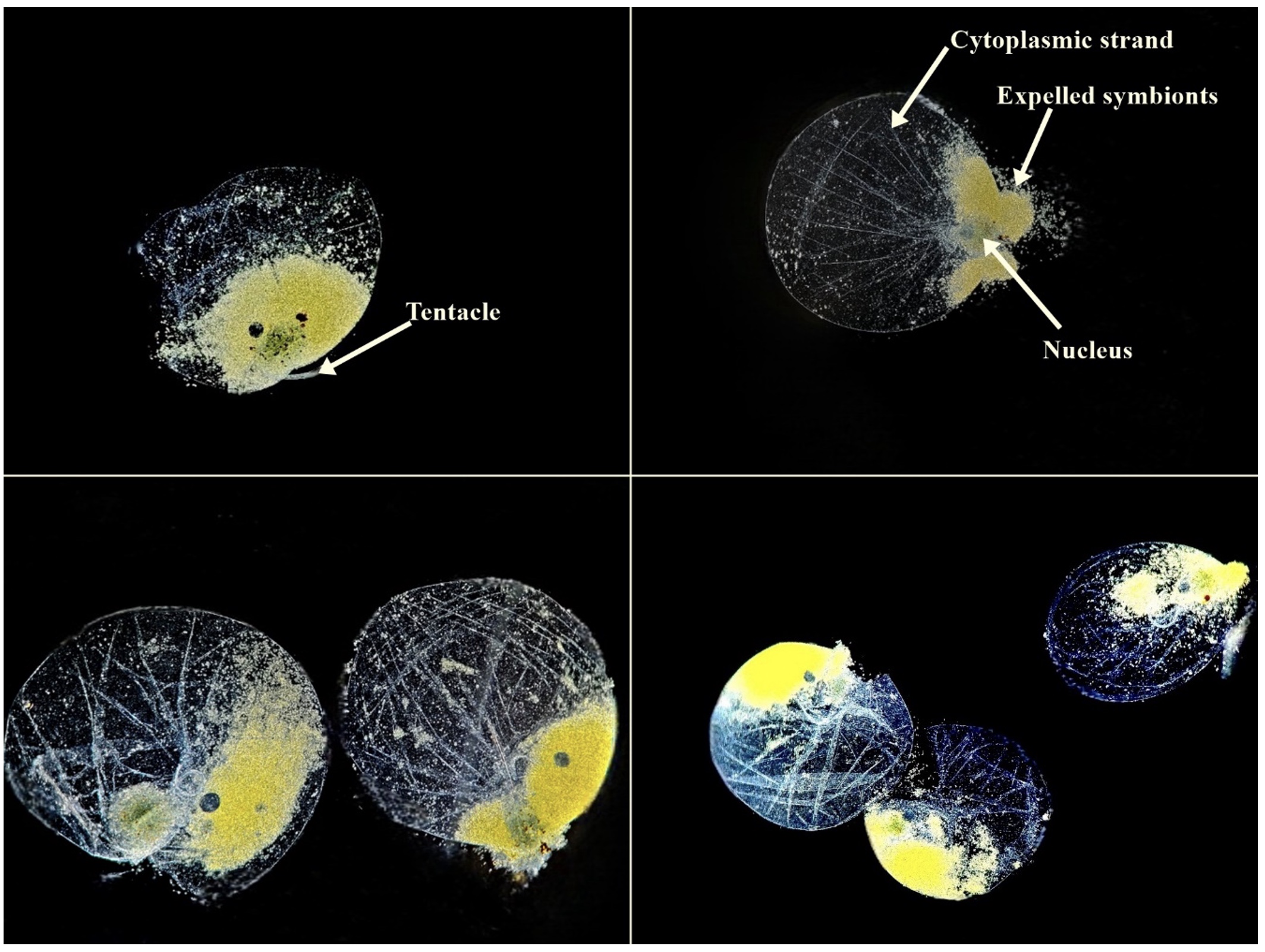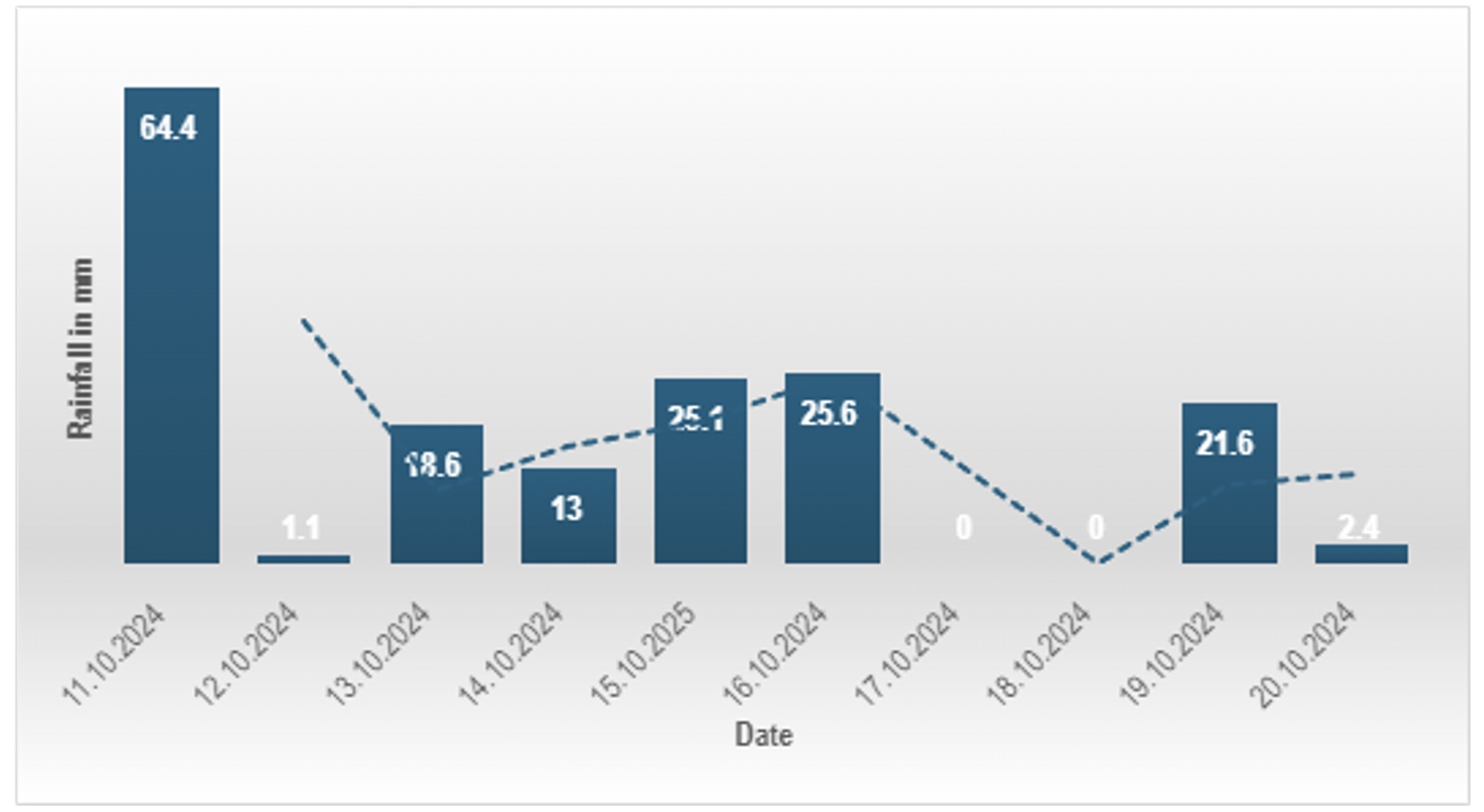The curious case of sparkling waves: Green Noctiluca bloom in Puducherry
Afreen Hussain, Arulmohan Rathinasamy, A Sakthivel, Punit Dhandhania
Kuddle Life Foundation, 29, Montorsier St, White Town, Puducherry, 605001.
The recent sighting of bioluminescence along the Chennai-Puducherry coast from 18-20 October 2024 drew visitors to the beaches, enthralled by the glowing blue waves (Figure 1-2). This natural phenomenon was observed after the recent heavy rainfall in Tamil Nadu and Pondicherry (The Indian Express, 2024). A closer examination of the seawater samples from Serenity Beach, Puducherry was conducted to identify the organism responsible for the sparkly glow.
Fig. 1: Bioluminescence observed on Serenity Beach, Puducherry on 20th October 2024.
Photos by Arpita Dutta.


Fig. 2: Green algal bloom, observed in and around Serenity Beach, Puducherry on 20th October 2024 in the morning.
Microscopic investigation revealed that the bioluminescence was caused by a small dinoflagellate- a kind of plankton Noctiluca scintillans, commonly known as the “sea sparkle” (Figure 3). When disturbed by waves or physical movement, these tiny organisms emit bright blue-green light due to a chemical reaction involving the enzyme luciferase

Fig 3: Dark Field micrographs of Noctiluca scintillans as observed under Imager 2.0 Zeiss Fluorescent microscope.
- scintillans is a non-motile, buoyant dinoflagellate that can grow up to 0.2 – 2 mm in diameter, though typically about 0.5 mm (Horner 2002) and can exist in green or red form. They maintain their buoyancy by regulating the ions concentration in the vacuole (Kahn and Swift, 1978) The red N. scintillans is a heterotroph and responsible for Harmful algal blooms, causing the red tides (Asefi et al. 2023). The green form as observed here has a photosynthetic symbiont inside called Pedinomonas noctiluca which gives the green color. The green form is mainly autotroph or even photoautotrophic depending on the abundance of photosynthetic symbionts (Piontkovski et al. 2021).
Let’s take a closer look at the phenomenon of Bioluminescence!
Bioluminescence is the natural production of light by living organisms. This light results from a chemical reaction that usually involves a light-producing molecule called luciferin and an enzyme known as luciferase (Widder 2010) (Figure 4). First described by Aristotle (384-322 BCE), who recognized the self-luminosity of organisms without the production of heat (Schramm & Weiß, 2024). Bioluminescence is found in a wide range of organisms, including deep-sea fish, jellyfish, plankton, certain fungi, and insects like fireflies (Herring P J & Widder, 2001).

Fig. 4: A schematic representation of bioluminescence using Luciferase.
Under what conditions do N. scintillans bioluminescence and bloom?
In marine settings, bioluminescence is most frequently seen in planktonic organisms, particularly dinoflagellates such as Noctiluca scintillans, which create stunning displays of glowing water when disturbed. These organisms use bioluminescent light for various functions, such as attracting mates, deterring predators, and catching prey (Prasad et al. 2023). This phenomenon typically thrives under specific conditions like adequate nutrients, low wind speed, a drop in sea surface temperature after heavy rainfall, and a high abundance of certain diatoms (Mishra et al. 2022). A study by Mishra et al. (2022) reported a sudden spike in abundance of Diatom Thalassiosira sp. and adequate nutrients supported N. scintillans growth following a heavy rainfall spell in August 2019, along the Chennai coast.
Pondicherry also observed spells of heavy rainfall in days preceding the algal bloom (Figure 5) and was put under red alert by the Regional Meteorological Centre (RMC) (The Indian Express, 2024)

Fig. 5: Average rainfall in Puducherry from 11-20 October 2024.
Environmental implications of N. scintillans bloom
Blooms are thought to generate high concentrations of ammonium, which can be toxic to fish (Horner 2002). These blooms have also been linked to mortality events in various marine invertebrates due to anoxia. Although N. scintillans itself does not produce toxins, it is classified as a harmful algal species (HAB) due to its potential to produce toxic levels of ammonium, deplete oxygen in the water, and clog the gills of other organisms (Escalera et al. 2007). Gopakumar et al. (2009) reported mortality of marine fauna and adverse effects in coral reefs of Guld of Mannar during the green algal bloom of N. scintillans during October 2008. Further investigation is needed to study the impact of Noctiluca bloom in coastal Tamil Nadu and Pondicherry and its impact on the fisheries.
Acknowledgements
We are thankful to the Department of Microbiology, Pondicherry University for microscopy and Ms. Arpita Dutta for her support in sampling.
References
- Asefi, M. A., & Attaran-Fariman, G. (2023). Harmful blooming of Noctiluca scintillans in the southeast coastal waters of Iran, Oman Sea. Iranian Journal of Fisheries Sciences, 22(2), 261-277.
- Escalera, L., Pazos, Y., Moroño, Á., & Reguera, B. (2007). Noctiluca scintillans may act as a vector of toxigenic microalgae. Harmful algae, 6(3), 317-320.
- Gopakumar, G., Sulochanan, B., & Venkatesan, V. (2009). Bloom of Noctiluca scintillans (Macartney) in Gulf of Mannar, southeast coast of India. Journal of the Marine Biological Association of India, 51(1), 75-80.
- Herring P J & Widder E A, Bioluminescence, In: Encyclopedia of Ocean Science, edited by Steele J H, Thorpe S A & Turekian K K, (Academic Press, Elsevier, San Diego), 2001, pp. 308–317.
- Horner, R. A. (2002). A taxonomic guide to some common phytoplankton. Harmful Algae, 2, 161-162.
- Kahn, N., & Swift, E. (1978). Positive buoyancy through ionic control in the nonmotile marine dinoflagellate Pyrocystis noctiluca Murray ex Schuett 1. Limnology and Oceanography, 23(4), 649-658.
- Mishra, P., Begum, M., Gera, A., Kumar, B. C., Deviram, G., Pradhan, U. K., … & Murthy, M. R. (2022). Factors responsible for the sudden outburst of Noctiluca scintillans in the Chennai coastal waters, southeast coast of India–a case study. Oceanologia, 64(4), 781-788.
- Piontkovski, S. A., Serikova, I. M., Evstigneev, V. P., Prusova, I. Y., Zagorodnaya, Y. A., Al-Hashmi, K. A., & Al-Abri, N. M. (2021). Seasonal blooms of the dinoflagellate algae Noctiluca scintillans: Regional and global scale aspects. Regional Studies in Marine Science, 44, 101771.
- Prasad, H., Siddique, A., Purushothaman, J., & Raghunathan, C. (2023). Perspectives on marine dinoflagellate bioluminescence: Is the current prevalence along the Indian waters only reckoned with aesthetic pleasure?. Indian Journal of Geo-Marine Sciences (IJMS), 52(06), 273-283.
- Schramm, S., & Weiß, D. (2024). Bioluminescence–The Vibrant Glow of Nature and its Chemical Mechanisms. ChemBioChem, 25(9), e202400106.
- The Indian Express: https://www.newindianexpress.com/states/tamil-nadu/2024/Oct/15/red-alert-issued-for-nine-districts-in-tn-and-pondicherry. Accessed on 25 October 2024.
Widder, E. A. (2010). Bioluminescence in the ocean: origins of biological, chemical, and ecological diversity. Science, 328(5979), 704-708.

Your support matters!
Help us reach more people. Share this post with your friends!